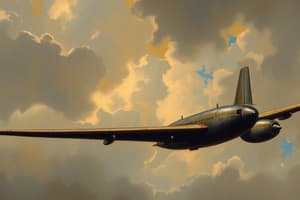Podcast
Questions and Answers
How is aerodynamic balancing of flight controls achieved?
How is aerodynamic balancing of flight controls achieved?
- By placing a weight in the leading edge of the control surface
- By providing a portion of the control surface ahead of the hinge point (correct)
- By placing a weight ahead of the hinge point
- By attaching a balance tab to the control surface
What is the primary purpose of aerodynamic balance?
What is the primary purpose of aerodynamic balance?
- To increase the aircraft's maneuverability
- To reduce the control load to zero
- To prevent flutter of the flying controls
- To make the flying controls easier to move (correct)
What is a horn balance?
What is a horn balance?
- A rod projecting upward from the main control surface to which the control cables are attached
- A projection of the outer edge of the control surface forward of the hinge line (correct)
- A device used to measure the balance of the control surface
- A rod projecting forward from the control surface with a weight on the end
How is a control surface mass balanced?
How is a control surface mass balanced?
What is the purpose of anti-balance tabs?
What is the purpose of anti-balance tabs?
Which motion of the aircraft does the elevator control?
Which motion of the aircraft does the elevator control?
What is the purpose of mass balancing on an elevator?
What is the purpose of mass balancing on an elevator?
Why are the outboard ailerons on some large aircraft isolated at high speeds?
Why are the outboard ailerons on some large aircraft isolated at high speeds?
What is the effect of excessive aerodynamic balance on a control surface?
What is the effect of excessive aerodynamic balance on a control surface?
What is the purpose of a flying control mass balance weight?
What is the purpose of a flying control mass balance weight?
What is attached to the rear of the vertical stabilizer?
What is attached to the rear of the vertical stabilizer?
What is the method employed to mass balance control surfaces?
What is the method employed to mass balance control surfaces?
What can cause control surface flutter?
What can cause control surface flutter?
Why is a 'frise' aileron incorporated?
Why is a 'frise' aileron incorporated?
How can aerodynamic balance of a control surface be achieved?
How can aerodynamic balance of a control surface be achieved?
What is the purpose of providing a control surface with aerodynamic balancing?
What is the purpose of providing a control surface with aerodynamic balancing?
What is the purpose of the extension to the rudder (shaded portion)?
What is the purpose of the extension to the rudder (shaded portion)?
What is the purpose of horn balance and inset hinge balance installed on control surface assembly?
What is the purpose of horn balance and inset hinge balance installed on control surface assembly?
In what direction does the fin help to provide stability?
In what direction does the fin help to provide stability?
Which control surfaces are considered primary?
Which control surfaces are considered primary?
What effect does an aerodynamic balance have?
What effect does an aerodynamic balance have?
How can flutter be reduced in an aircraft?
How can flutter be reduced in an aircraft?
What is the main function of roll spoilers on an aircraft?
What is the main function of roll spoilers on an aircraft?
Flashcards are hidden until you start studying
Study Notes
Flight Control Surfaces
- Control surfaces are the ailerons, elevators, and rudder that control the aircraft's movement
- These surfaces use aerodynamic balance to reduce the force required to move them
Aerodynamic Balance
- Aerodynamic balance reduces the force required to move control surfaces
- Achieved by:
- Horn balance: a projection of the outer edge of the control surface forward of the hinge line
- Inset hinge balance: a recessed area in the control surface near the hinge line
- Mass balancing: attaching weights ahead of the hinge line
- Effects of aerodynamic balance:
- Reduces control column load
- Makes flying controls easier to move
- Does not affect aircraft stability
Control Surface Types
- Primary control surfaces:
- Elevators: control pitch
- Ailerons: control roll
- Rudder: control yaw
- Other control surfaces:
- Tabs: small, adjustable surfaces on control surfaces
- Spoilers: devices that reduce lift
- Flaps: devices that increase lift during takeoff and landing
Stability and Control
- Directional stability: the aircraft's tendency to maintain direction
- Longitudinal stability: the aircraft's tendency to maintain pitch
- Lateral stability: the aircraft's tendency to maintain roll
- Control surfaces maintain stability by:
- Providing opposition to unwanted movements
- Assisting the pilot in moving controls
Mass Balancing
- Mass balancing:
- Attaches weights ahead of the hinge line
- Moves the control surface's center of gravity (C of G) closer to the hinge line
- Reduces the force required to move controls
- Methods of mass balancing:
- Attaching weights forward of the hinge line
- Using bias strips on the trailing edge of the surface
Flutter
- Flutter: rapid, oscillating movement of control surfaces
- Causes of flutter:
- Excessive play in trim tab attachments
- High static friction in trim tab control tabs
- Incorrect angular movement of trim tabs
- Methods to reduce flutter:
- Mass balancing
- Aerodynamic balancing
Studying That Suits You
Use AI to generate personalized quizzes and flashcards to suit your learning preferences.




